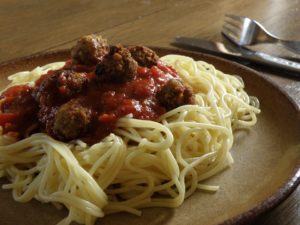Happy National Sauce Month.
In some parts of the US, the easiest way to start an argument is the battle of sauce vs. gravy in relation to what people put on their pasta or macaroni. Primarily, the battle rages in the northeast with Philadelphia a major supporter of gravy. My preference is sauce but I can’t begin to tell you how many times I’ve been challenged on this by people who insist that their grandma was “off the boat” and she called it gravy.
their pasta or macaroni. Primarily, the battle rages in the northeast with Philadelphia a major supporter of gravy. My preference is sauce but I can’t begin to tell you how many times I’ve been challenged on this by people who insist that their grandma was “off the boat” and she called it gravy.
Well, I’m first generation and would be considered “off the boat” and I call it “sauce”.
Pop culture doesn’t provide an answer either.
In The Sopranos, Paulie Walnuts visits Naples and asks for “macaroni and gravy”. The waiter looks confused and his native buddies translate and ask that he bring Paulie some pasta with tomato sauce (it’s at the 14-second mark in this video).
The Big Night, the wonderful movie featuring Timpano doesn’t mention sauce or gravy but the New York Times recipe refers to sauce.
Cook’s Illustrated had a very thorough explanation several years back.
When Italians first arrived in the U.S., they were taken aback by the abundance of meat that was available to them. Back home, they weren’t able to get meat as readily and tomato sauce was just made from tomatoes, olive oil, garlic, onions, and spices. In their new home, they began to add meat – sausage, meatballs, and braciole. Additionally, newly arrived Italians were eager to assimilate. What could be more American than having gravy on your food so they started to call what they put on their pasta Sunday gravy.
So yes, nonna called it gravy but it was her way of showing she was American not because it was an indication of being a super Italian.
In the end, it really doesn’t matter — in actuality, either one is correct. Calling it gravy is a tribute to your grandmother who’s recipe for Sunday gravy is still made to this day.
As Andrew Zimmern would say, “if it looks good, eat it!” and stop worrying about what to call it.

